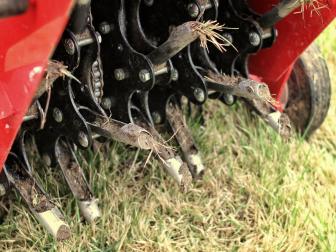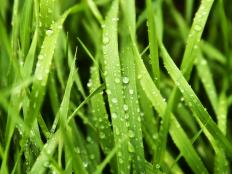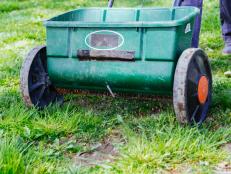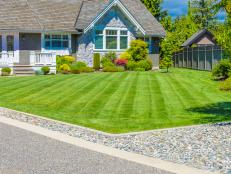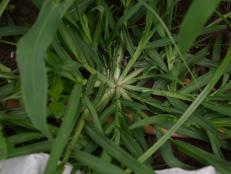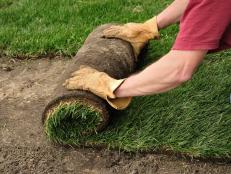How to Grow Zoysia Grass
Known for its ability to stand up to heat, drought and heavy foot traffic, this warm weather grass is a popular choice for suburban lawns.

Image courtesy of Ben Rollins

There are a lot of grasses out there for your lawn, but if you need one that can stand up to heat, drought and foot traffic, zoysia grass is the grass for you. Zoysia grass is often used in parks, golf courses, athletic fields and other places where being tough is key. That hardiness has made zoysia grass one of the most popular lawn grasses in the southern United States.
Zoysia Grass 101
Zoysia is a warm season grass native to China, Japan and other parts of Southeast Asia. The species was named in honor of an 18th century Austrian botanist, Karl von Zois, and introduced to the United States in the early 20th century. Zoysia grass grows into a dense turf that resists weeds and stands up to wear. Zoysia is tolerant of drought because it has a deep root system that lets it pull water from deep in the soil in times when the rain doesn’t come. Zoysia is also tolerant of salt, so it’s a good pick for seaside areas.
There are two types of zoysia grass commonly used for lawns:
Zoysia japonica (Japanese or Korean lawn grass.) It has a coarse texture and is more tolerant of cold than other warm season grasses. This is the only type of zoysia available as seed.
Zoysia matrella (Manila grass.) Z. matrella has a finer texture than Z. japonica and is not as tolerant of cold. It grows more slowly and does not need to be mowed as often.
Botanical Name: Zoysia spp.
Common Name: Zoysia grass
Plant Type: Perennial
Light Needs: Full sun to part shade
Hardiness Zones: 5 to 10
Planting Zoysia
The best way to establish a zoysia grass lawn is by planting sod. You can grow some types of zoysia from seed, but that’s a slow, difficult process that most people don’t want to tackle. It will take you two seasons to go from seeds to turf, and you’ll have to baby the zoysia every step of the way. Buying squares or rolls of zoysia sod and transplanting them to your yard is a much better way to go. You can get an instant yard with a fraction of the work.
Zoysia grass can tolerate a wide range of soil types, even acidic soil, which is one of the reasons it is so popular. It’s still a good idea to test your soil before putting down sod and amend it with organic material like compost. Zoysia needs full sun to be its best. The shadier your yard, the thinner and weaker your zoysia grass will be. If much of your yard is in deep shade, consider choosing another type of groundcover.
Caring for Zoysia
Zoysia doesn’t need a lot of water or nutrition, and it resists weeds because of its thick growth pattern. That means you won’t need to do a lot of fertilizing, irrigating or herbicide-spraying once it is established. Zoysia, as a warm season grass, turns brown and goes dormant after the first hard freeze. It turns green and starts growing again when soil temperatures hit 70 degrees.
Watering
Zoysia grows best on an inch of water per week, but it’s drought tolerant and withstands dry spells. If your soil is heavy on clay, compacted or in a low area where poor drainage is an issue, adjust your irrigation to put less water on the zoysia grass.
Mowing
Start mowing your zoysia grass when it greens up in the spring. Keep the grass blades 1.5 to 2 inches tall. When you mow, never cut more than a third of the total grass blade height. Cut your zoysia grass too short, and it won’t be as thick or as healthy.
Fertilizing
Depending on your soil type, zoysia grass is happiest with three to five feedings a season. Wait until your lawn has completely greened up in the spring before fertilizing zoysia grass. Make the second feeding(s) midsummer. And make the last feeding at least six weeks before your first frost date. Over-fertilizing will cause a dense layer of roots and stems — known as thatch — to build up, and that’s bad for your grass.
Aerating and De-thatching
Thatch is the layer of dead and living shoots, stems and roots that develops between the living grass blades and the surface of the soil. If this layer gets too thick, it can keep air, water and nutrients from reaching the roots of the grass. Remove the thatch in your zoysia grass in the fall, just before it goes dormant, with a rake or a specialized lawn de-thatcher tool.
If you live in an area with clay soil or have a yard where kids and pets romp daily, you will also need to aerate your yard annually. Aerating pokes holes in compacted soil so that air, water and nutrients can reach the grass roots. You can DIY it with a special lawn aeration tool or hire a lawn service to aerate your lawn. The best time to aerate zoysia grass is in late spring or early summer.
How to Aerate Your Lawn
Lawn aeration encourages deep roots, resulting in a healthy lawn. Learn how to give your grass a breath of fresh air with these aerating tips.
Overseeding
You can thicken up a thin lawn by overseeding it with zoysia grass seeds in late spring. Wait until all threat of frost has passed and sprinkle your grass with seeds. If you want some temporary winter color in your zoysia grass in winter, overseed the lawn with ryegrass, a winter grass.
Pests and Diseases
Lawn grubs from Japanese beetles or June beetles can attack zoysia roots in summer, but a few grubs won’t cause visible damage. If you have a big outbreak of grubs, treat it with a preventative pesticide the following spring, before they hatch.
Fungal diseases like large patch can damage zoysia. Large patch disease is the bane of all warm weather grasses. It’s caused by too much nitrogen and thatch or by inadequate drainage. Large patch disease appears as circular patches of discolored grass. Grass on the edge of the patch will be orange or yellow, and grass in the middle of the patch will be brown — as in dead. Large patch is tough to get rid of once it gets started, so preventing it is the way to go. To stop large patch disease from striking your zoysia grass, improve drainage, remove thatch, don’t over-fertilize and water zoysia only when necessary.
How Does Zoysia Compare to Other Grasses?
Zoysia is one of several types of warm weather grasses. Here’s how it compares with other varieties.
Zoysia Grass vs. Bermuda Grass
Bermuda is more tolerant of heat and grows like crazy in southern states in Zones 7 to 10. Bermuda grows so fast that it needs more water, more fertilizer and more mowing, so you’ll do a lot more work in a yard full of Bermuda grass than a zoysia grass yard. Live at the beach? Opt for Bermuda grass because it’s the most salt-tolerant lawn grass out there.
Zoysia Grass vs. St. Augustine Grass
St. Augustine is the most shade-tolerant of all the warm-weather grasses, so it’s a good choice if your yard isn’t in full sun. St. Augustine is more prone to mildews than zoysia, and it doesn’t hold up to foot traffic as well as zoysia. St. Augustine doesn’t grow as fast as zoysia, so you won’t have to mow it as often.
Zoysia Grass vs. Centipede Grass
Centipede does best in sandy soil in full sun. It grows slowly, so you’ll need to mow it less often than zoysia. Centipede doesn’t grow well in heavy soil, so if you have clay in your yard, go with zoysia grass instead. Centipede grass has a shallower root system than zoysia, so it’s not as drought tolerant. It will need more irrigation in dry spells.






